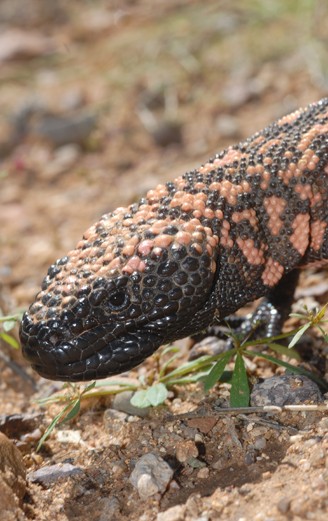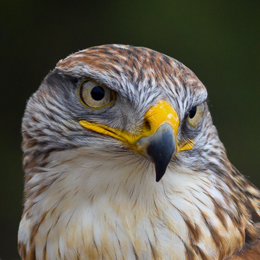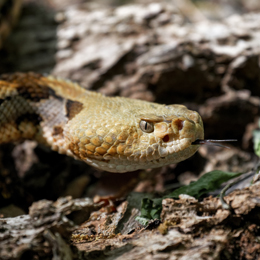Description
The scientific name Heloderma suspectum describes a lot about this creature. The term “Heloderma”, stands for “nail-studded skin” and is given to this lizard as its skin is completely covered with tiny osteoderms. Edward Drinker Cope, an early paleontologist, was the first to suspect that the Gila monster uses venom to kill prey, thus, to honor his precise suspicion, the species was named Heloderma suspectum.
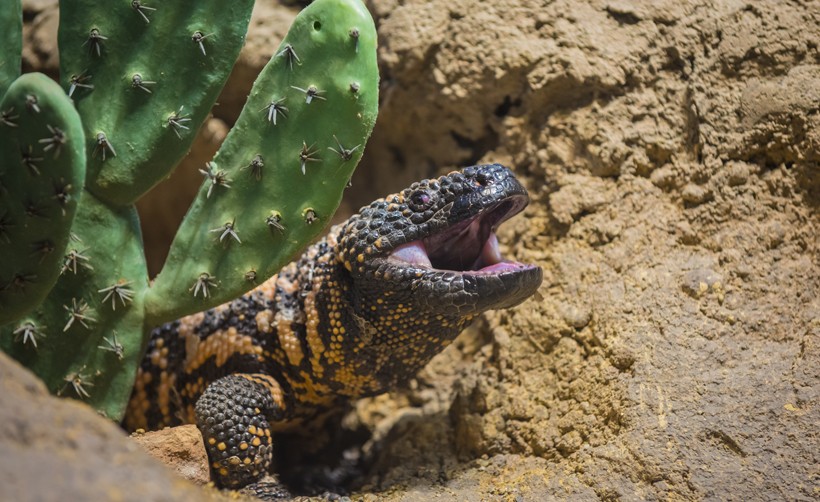
Gila monsters can be seen basking in the sun every morning.
?
Image credits: Kris Wiktor/Shutterstock
The species is more commonly known as the Gila monster as they are found commonly around the Gila River basin. They are easily identifiable due to their bright pink and black colored skin and thick tail. Like most lizards, Gila monsters are sexually dimorphic creatures, which means that males and females have physical differences. The male Gila monster has a more massive head compared to that of females. In males, the tail tapers evenly to the tip while the tail in females is a little bulged at the center. These visible features allow researchers to identify the sexes of Gila monsters without capturing the lizard.
In the wild, a Gila monster can survive for 20 years while under captive circumstances, the lifespan can be up to 30 years. The average size they reach is from 26 to 36 cm (snout to vent). Large adults measure up to 51-56 cm (20-22 inch) in length, with the tail making up only 20% of its entire length. These lizards store fat in their tales and under the skin in order to survive the harsh weather in the deserts of North America.
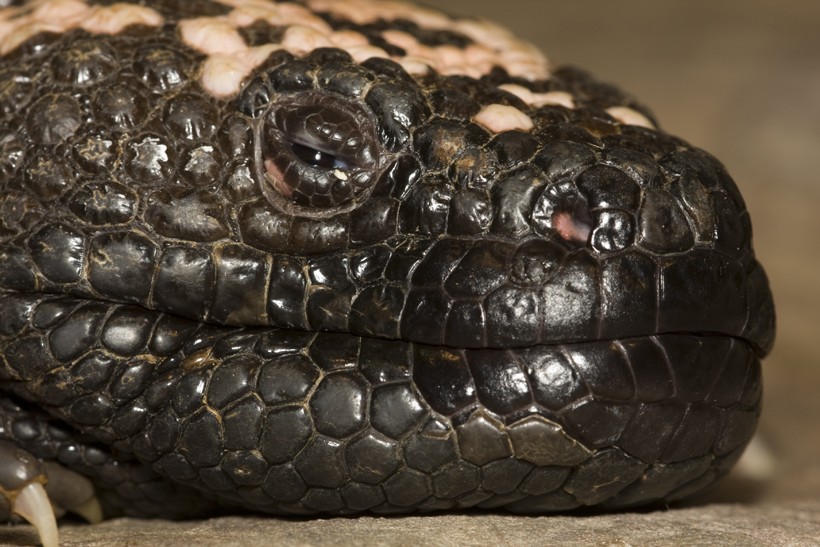
The skin of the lizard is completely covered with tiny osteoderms.
?
Image credits: Bildagentur Zoonar GmbH/Shutterstock
An adult can weigh as much as 2 to 2.3 kilograms although the average is only 500 grams. When the Gila monster is hungry, it can eat up to one-third of that mass. Gila monsters are highly intelligent predators and by its senses, they are able to detect a prey precisely. Apart from the senses of smell, hearing and vision, the Gila monster has a super sense. Like most reptiles, the Gila monster has a forked tongue. The lizard constantly flicks the tongue and takes it back to a unique organ in its mouth. This organ, known as the Jacobson’s organ is capable of analyzing the chemical information received from the tongue. With the help of this Jacobson’s organ, the Gila monster can get vital information about its surrounding, without even moving out of its burrow.
A Gila monster bite can be as painful as a rattlesnake bite but it is not usually fatal to humans as the amount of venom injected is quite low. The Gila monster does not use fangs to inject venom. The venom glands are actually located on the sides of its lower jaws and the venom seeps out from its teeth when the Gila monster gnaws after biting its prey.
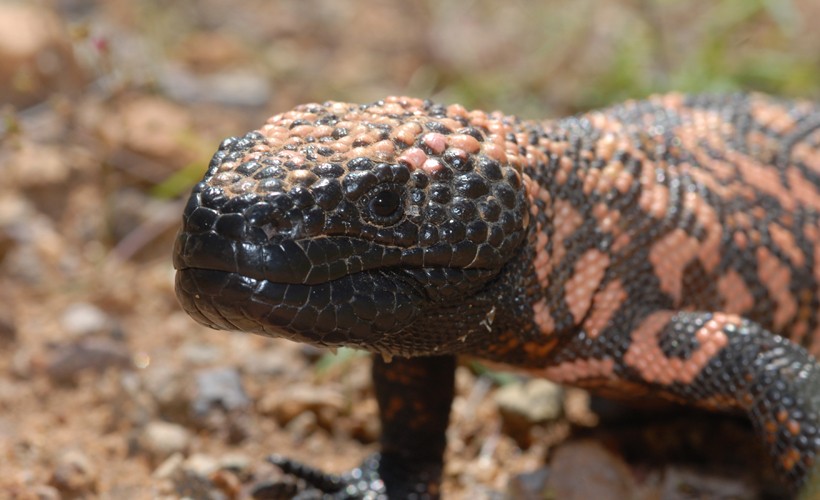
Reticulated Gila Monster
?
Image credits: Rusty Dodson/Shutterstock
Two subspecies of Heloderma suspectum have been recognized so far. The nominated subspecies H. s. suspectum is also known as the reticulated Gila monster, as they have a reticulated and irregular pattern of pink and black color on the back. The subspecies Heloderma suspectum cinctum or the banded Gila monster can be identified easily, as the pink and black colors form regular banded patterns on its back.
Habitat
Gila monsters prefer scrublands and dry succulent deserts in Western North America. Like most reptiles, the Gila monster is a cold-blooded animal, which means that the reptile has to depend on its surroundings to maintain the inner body temperature at an appropriate level. Most of the time, the Gila monster stays in burrows and shades, to keep itself safe from the extreme temperatures of its habitat.
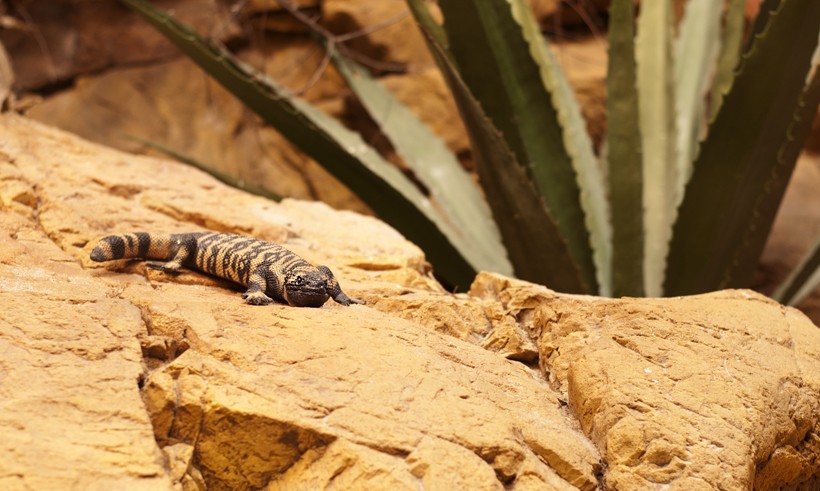
Banded Gila Monster basking in the sun
?
Image credits: DreamBig/Shutterstock
Gila monsters can be seen basking in the sun every morning. This behavior allows them to warm up for the rest of the daily chores. Once its body has been warmed up, the Gila monster becomes more active and moves out in search of food. It uses a stealth and ambush technique or simply follows its prey back to its burrow, where the giant reptile can bite the unexpected prey deathly. Gila monsters prey on a wide range of animals like small mammals, rodents, insects, frogs and even small birds. Gila monsters are also highly efficient nest raiders and scavengers. It is thus safe to say that the Gila monster is fit for the desert, as it does not miss an opportunity of finding a good meal.
With a painful and venomous bite in its arsenal, the Gila monster faces very few natural predators in the wild. To minimize the risk of predation, the Gila monster spends most of its lifetime in the safety of its burrow. Coyotes, birds of prey and some snakes are the only creatures capable of taking down a Gila monster. Hunting a Gila monster is quite risky for a predator, especially due to its venom; thus, most predators tend to avoid this pink-black lizard and choose rather easier prey instead.
Reproduction and Lifecycle
Gila monsters reach sexual maturity at an age of 3 to 5 years. Their mating season starts in late spring month April. During this period, males are constantly searching females. When two males sense the same female for mating, they compete for the mating rights. Such a mating fight is not fatal as they don’t bite each other; they simply push each other till one gives up and withdraw.
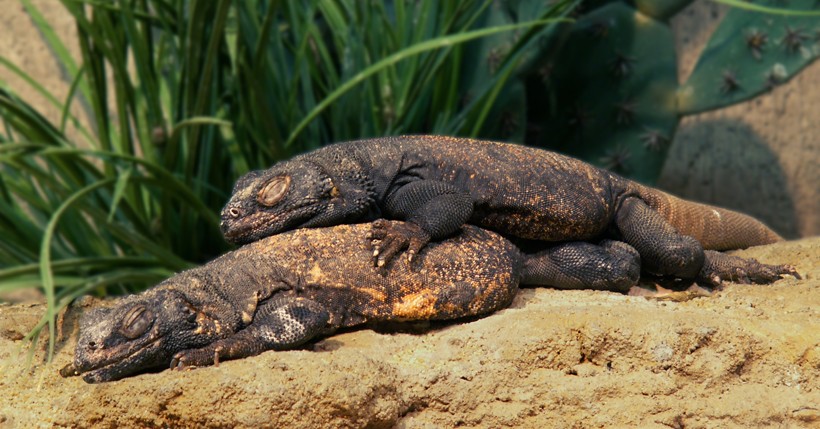
Gila monster couple sleeping
?
Image credits: Keith Allen Hughes/Shutterstock
Afterwards, the winning male enters the female’s burrow, seeking her to copulate. The copulation time ranges between few minutes to up to two and a half hours. Approximately 40-45 days after mating, the female lays 2-30 eggs in her burrow. The litter size depends on climatic conditions of her habitat. Higher temperatures often result in a lower number of eggs and hatchlings. The eggs are at a high risk as the female tends to eat them when food is scarce. Other predators like snakes and coyotes can also raid the Gila monster burrow for the eggs.
The incubation period for Gila monster eggs is one of the longest amongst reptiles. Gila monsters incubate the eggs for up to 9-10 months. Most hatchlings leave their eggs between the months of April and June. Hatchlings may take up to 4 to 5 days to completely emerge out from their eggs. The remaining egg yolk acts as the first meal for the Gila monster hatchlings.
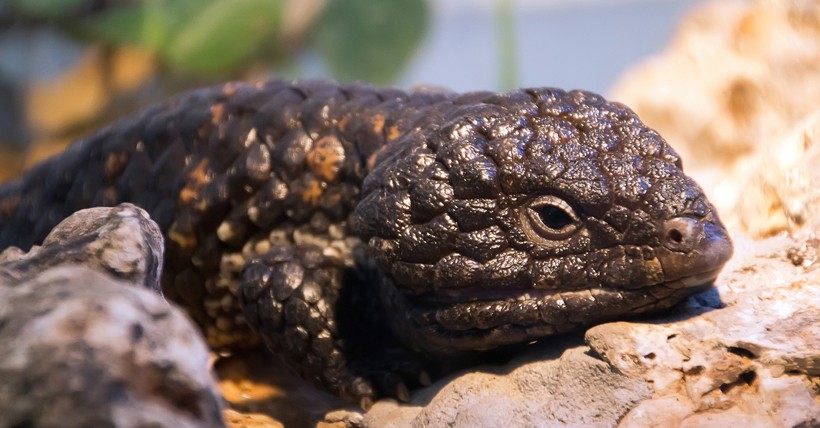
Their small size of the hatchlings make them an easy prey for many predators.
?
Image credits: Jose Angel Astor Rocha/Shutterstock
The hatchlings are small; only a few inches in length, but they can survive on their own as soon as they hatch. They feed on small insects at first and, later on, move to larger prey as they gradually gain size. Life is tough for newborn Gila monsters. Their small size makes them an easy prey for many predators. Lizards, insect-eating birds, and small mammals easily hunt the hatchlings down, resulting in a very low survival rate for young Gila monsters.
No encounters of any hybrid Gila monster have been reported so far.
Behavior and Communication
Gila monsters are slow and sluggish reptiles that prefer a solitary lifestyle in the dry scrublands and deserts of western North America. They spend above 90% of their lifespan inside their burrow, in order to stay safe from predators and the harsh climate of its habitat. Gila monsters can be spotted in the morning as they usually leave their burrow for basking in the sun. Most of the activities are observed during the day. As the temperatures drop during the night, the Gila monster prefers to stay hidden in its burrow. Their metabolism rate at rest is very low, allowing the lizards to survive harsh climates and scarcity of food.
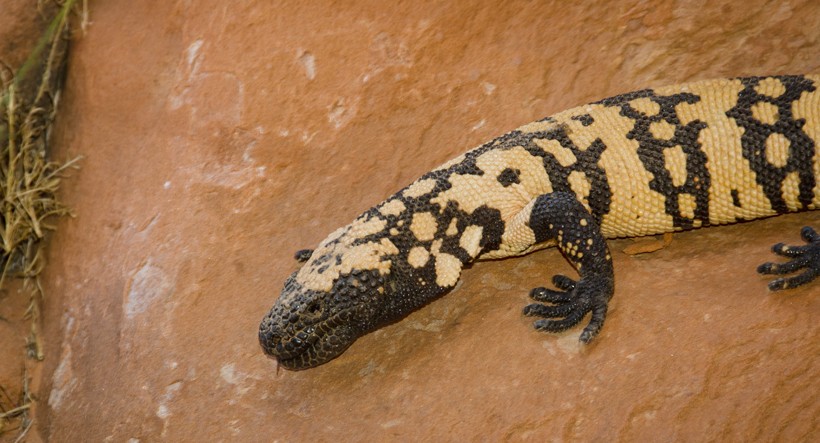
Banded Gila Monster, Valley of Fire State Park near Las Vegas, Nevada
?
Image credits: Terry W Ryder/Shutterstock
Contact with other members of their own species happens only during the mating period and it is for only short time intervals. Thus, it is concluded that Gila monsters conduct only minimal to no communication at all with other Gila monsters in its range.
A Gila monster may look sluggish, but it can bite very quickly. These reptiles also display a remarkable amount of intelligence while dealing with daily tasks. Researchers have often spotted Gila monsters climbing up cacti plants in order to raid nests for eggs. A Gila monster is also known to follow small mammals to its burrow, in order to feed on the young ones. If the burrow contains no newborns, the Gila monster may visit the mammal burrow again and again, till it finds young ones for an easy meal. This behavior clearly indicates that the Gila monster has a tremendous ability to memorize important information about its habitat. It is believed that its memory can consist data of up to 20 years of its lifespan. Clearly, the Gila monster is a mastermind of its kind.
Population and Conservation
Though the Gila monster proves to be highly efficient to survive, their population numbers are dwindling due to habitat loss and predation. The current Gila monster range of distribution is very small and includes Arizona and Sonora, along with some parts of California, Nevada, Utah, and New Mexico. Several myths have surrounded this creature since the time it was spotted by humans. It is still believed by many that the Gila monster has a poisonous breath and its bite can be fatal to humans.
Such superstitions, along with the name “monster” attached to it, lead to unnecessary hatred towards this calm and shy lizard.
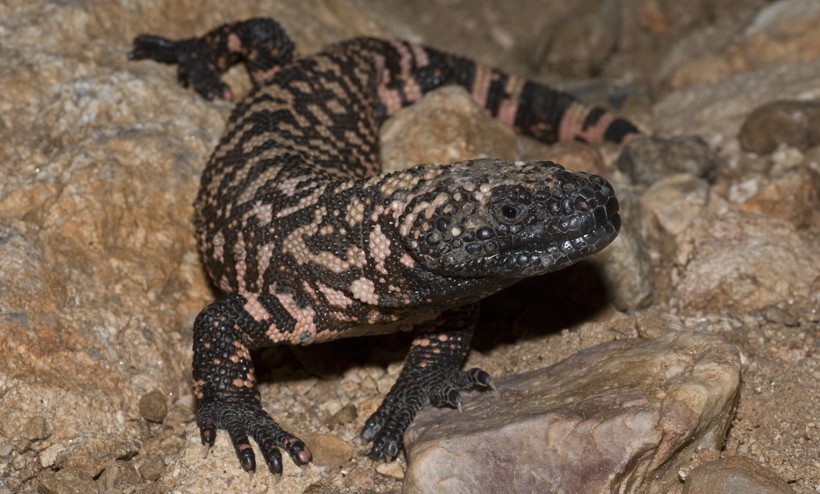
The Gila Monster is a near threatened species
?
Image credits: Jason Mintzer/Shutterstock
IUCN assessments report that the Gila monster population is dropping significantly, with only a few thousand adults remaining in the wild. Habitat loss is one of the major threats to this creature. Gila monsters are conserved and bred in several protected areas in the United States, with a vision to give the animal a fighting chance for its survival. Though killing a Gila monster in the United States is illegal, humans often kill this animal out of fear. The IUCN rates this animal as a “Near Threatened” species.
Several campaigns and awareness programs are carried out periodically in order to educate people about this fascinating lizard. The Gila monster is also the official mascot of the Eastern Arizona College. The official mascot Gila monster wearing a Cowboy hat and holding guns in its hand describes the Wild West in the best way possible.
Evolution
Gila monsters belong to the family Helodermatidae, consisting of venomous lizards. These lizards belong to the order Squamata which is the name given to the group of all modern scaled reptiles. Fossil records show that modern squamates evolved during the mid-Jurassic period. These early squamates resembled modern snakes and geckos. The oldest snake fossil discovered, dated back up to 90 million years.
One of the oldest known ancestors of modern Gila monsters is the Cryptolacerta. A complete fossil of Cryptolacerta was discovered in Germany, providing clues that this ancestral species belonged to the Eocene epoch era approximately 45 million years ago.
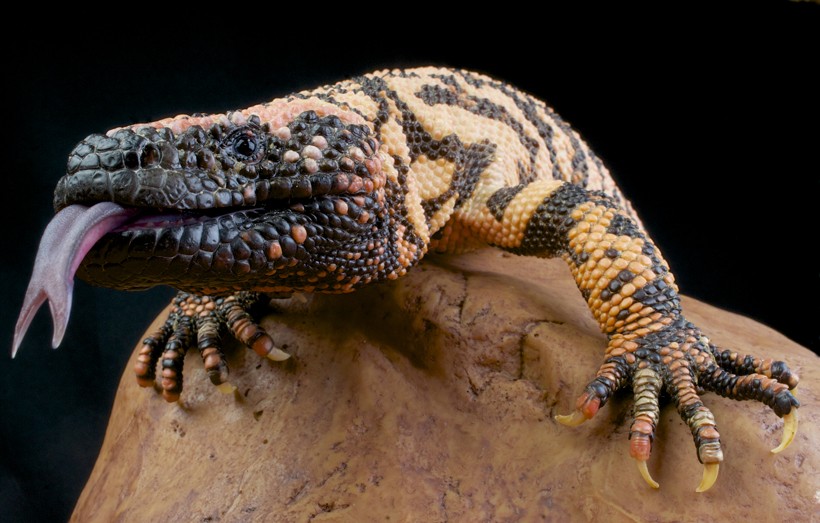
One of the oldest known ancestors of modern Gila monsters is the Cryptolacerta.
?
Image credits: reptiles4all/Shutterstock
Based on the adaptations of modern snakes and venomous lizards, it is believed that both types of reptiles split from a common venomous ancestor. Venomous lizards like the Gila monster and Mexican beaded lizard underwent numerous adaptations to survive the desert habitat.
Their scaly skin, grooved teeth and skin color are all designed for survival in the dry scrublands and deserts. The oldest yet closest relative of all modern Gila Monsters is the Heloderma Texana, which lived during the Miocene era.
Osteoderms of Gila monsters have been found on many fossils dating back up to 9000-8000 years.
Funfacts
- The Gila monster is the largest lizard in the United States.
- The Gila monster and the Mexican beaded lizard are the only two species of venomous lizards found in North America.
- A Gila monster has venom glands in the lower jaw and the venom is injected into the prey as the lizard chews after biting.
- Gila monsters have a remarkable memory. Their memory can encompass over 20 years of its lifespan.
- Captive breeding of Gila monsters began during 1963. San Diego Zoo was the first to conduct a successful breeding program in captivity.
- The Gila monsters' venom is as powerful as rattlesnake venom, but the Gila monster delivers only a little amount of it.
- Gila monster venom is not fatal to humans.
- The 2011 animated film named “Rango” featured a Gila monster as one of its characters.
- Gila monster saliva contains a protein, which is being used to produce a drug that can help in managing Type-2 diabetes.
